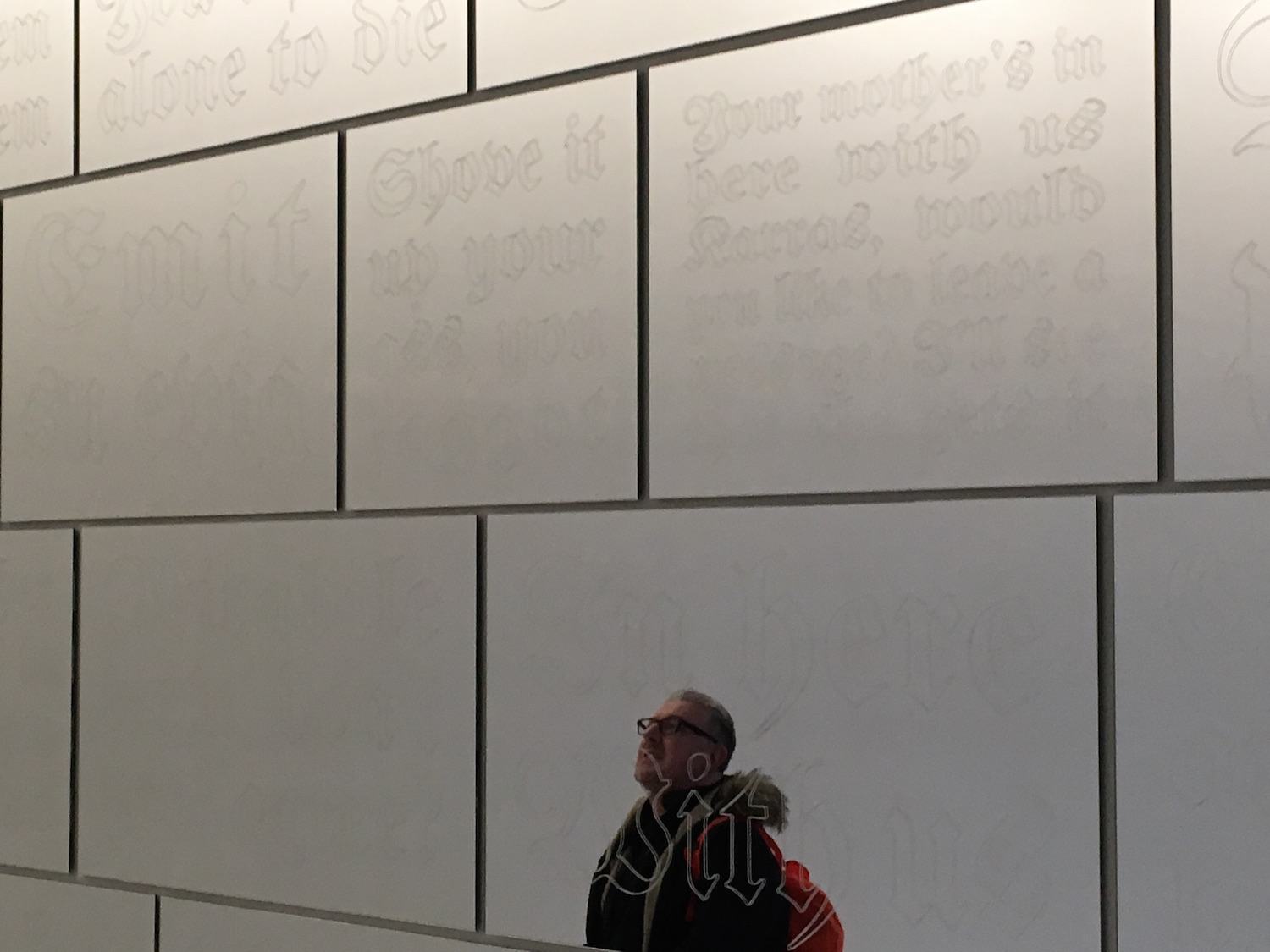Violence and Catharsis on Exhibit at Goya Contemporary by Angela N. Carroll
Skeleton bones rape and drag a woman along the fragile glass back of another woman whose body elongates into a pistol. Ornately beaded bullets bare the initials of Black men who have been murdered by police. Ghostly lithograph images of children smile as they dangle upside down, muscles and bones exposed to the gaze of onlookers. The urgency relayed in Joyce J. Scott’s sprawling collection of works is palpable in Still Happening in 2018, a solo exhibit at Goya Contemporary.
The work of MacArthur Genius Joyce J. Scott, whose 40+ year career has engaged benign crafting traditions to bring attention to the persistence of brutality against women, children, and men of color, is distinctly disturbing, offering stark depictions of violence which are haunting yet somehow beautiful.
As the title of her latest exhibition suggests, violence against those who have historically been marginalized and disrespected, devalued and forgotten, bought and sold, and touched without consent continues. The violations Scott has tackled throughout her career are as contemporary as they are pandemic: depiction of colonization, sex trafficking, unjustified murders, kidnapping, and child abuse recur in this exhibition of new and timeless visceral works.
Walking through any Joyce J. Scott exhibition is an intense experience, where works that forefront explicit traumas are both inspiring and deeply overwhelming. This paradox grounds my love/hate relationship with Scott’s work which often contrasts beautiful objects with horrid acts. The press release for the exhibition includes a quote from Scott that acknowledges the contradictions her work presents, but also determinedly recognizes the power of representing violence:
“I’d like my art to induce people to stop raping, torturing, and shooting each other. I don’t have the ability to end violence, racism, and sexism, but my art can help them look and think.”
There is no question that Scott’s use of crafts reflects extraordinary skill, and also contributes to broader passionate debates about the practice of employing trigger images to critique violence. Amy Raehse, Goya Contemporary Executive Director and Curator considers the work to be “clever with the best intentions.”
“It’s a huge contradiction,” Raehse continues, “[Joyce] excels at having these huge contradictions that draw people into the process before they realize what the subject is actually about.”

Several lithographs from the six-print series Soul Erased, originally created in 1999, and newer works rendered in a similar style, feature prominently in the exhibition where “Unable to be Released,” “Slack Like an Animal Carcass,” “Hell’s Angel” and other works from the series present chilling observations about child molestation. Scott revised old lithograph plates to render new monoprints, so some may look familiar. By painting on plexiglass and transposing the paintings with the lithograph prints, Scott expounds upon an already profoundly resonant series.
The final lithograph prints exude an eerie semi-transparent iridescence that makes the small skeletons, skin, and minimal attire on the childrens contorted bodies sparkle. In “Unable to Be Released,” a child dangles upside down with a cape tied around his/her neck. A large lock anchors and tightens the cape around the childs neck. His/her face is grayed and strained; their body is reduced to bones.

The Still Happening exhibition also includes more subtle works that interrogate colonialism and revere figures like Harriet Tubman who worked to dismantle the institution of chattel slavery. Four small bead-and-thread relief sculptures, “Map of Africa,” “Manifest Destiny,” “Map of South America,” and “Before White People,” are installed inside one deep glass frame against a matte black background.
Although flat, the fuscia and golden orange renderings of Africa and South America are placed alongside pearl-white maps of America and portions of Southern Europe, where the white shapes are considerably smaller than those of color. In gleaming beaded shapes, Scott directly implicates some of the empires who were directly responsible for, and drew unparalleled wealth from, the transatlantic slave trade, destabilization, and colonization of continental Africa and South America.
In contrast, “Harriet’s Rifle,” an intricate glass sculpture and one of the most beautiful works in the exhibition, is a marvelous memorial to the tireless freedom efforts of Harriet Tubman. Created in collaboration with renowned glass artist Tim McFadden as part of a larger exhibition at Grounds for Sculpture called Harriet Tubman and Other Truths, “Harriet’s Rifle” offers intricate glass detailing with birds, insects, and small figurines adorning the large glass rifle. The work was created after a residency on the Italian island of Murano, where Scott studied glassblowing from Venetian masters. “Harriet’s Rifle” is a welcome and celebratory addition to an otherwise heavy exhibition, contributing to a long tradition of using violence to critique violence.
In truth, I am weary from ingesting the regular brutality of real life as well as an aesthetic strategy in contemporary art. I believe that the persistence of such imagery numbs and fetishizes more than it prompts critical responses from voyeuring publics. However, I am also encouraged by Scott’s desire to continue to render those works as a hopeful means to prompt dialogue and potential action towards the eradication of violence.
Still Happening in 2018 is a cathartic and profound exhibition that stands in solidarity with all those unknown and remembered who have been victim to persistent violations, offering glittering and colorful objects to channel collective pain.

Joyce J. Scott: It’s Still Happening in 2018 is up through May 9, 2018 at Goya Contemporary.
Reception Thursday April 5, 2018 6pm – 8pm.










